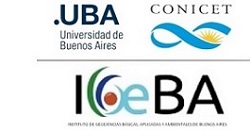Environmental Impacts of an Alien Kelp Species (Undaria pinnatifida, Laminariales) Along the Patagonian Coasts
Libro: Impacts of Invasive Species on Coastal Environments

Capítulo 10: Environmental Impacts of an Alien Kelp Species
(Undaria pinnatifida, Laminariales) Along the Patagonian Coasts
Autores: M.P Bunicontro, S.C. Marcomini, G.N. Casas
Abstract
Undaria pinnatifida (Harvey) Suringar was recorded in Argentina for the first time
in December 1992. Since then, it shows an invasive and competitive behavior,
spreading quickly from the initial focus and increasing its population density. The
first individuals were found attached to the port of Puerto Madryn, suggesting that
the vector of introduction was the ballast water of cargo ships arriving to Golfo
Nuevo from overseas. Since U. pinnatifida was recorded, it has been spreading
along the Argentina coasts, extending its range within and outside Golfo Nuevo,
along the coasts of Argentina from Puerto Deseado (Santa Cruz province) to
Mar del Plata (Buenos Aires province) far as 1850 km from each other. The
invasive condition of this species creates an awareness of the effects inflicted
upon the indigenous biodiversity of this region, as well as, on the
commercially-important benthic community structure. Moreover, the detachment
of subtidal algae, especially during the summer, and its deposition upon the
beach, have altered the sedimentary balance along the overall transverse beach
profile. This effect, in addition with algal extraction by trucks mainly during tourist
seasons, may increase beach erosion processes along Patagonian coasts.
![]()
